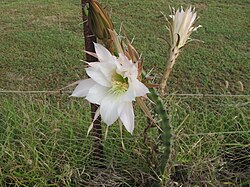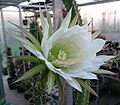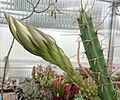Biology:Harrisia pomanensis
| Harrisia pomanensis | |
|---|---|

| |
| Scientific classification | |
| Kingdom: | Plantae |
| Clade: | Tracheophytes |
| Clade: | Angiosperms |
| Clade: | Eudicots |
| Order: | Caryophyllales |
| Family: | Cactaceae |
| Subfamily: | Cactoideae |
| Genus: | Harrisia |
| Species: | H. pomanensis
|
| Binomial name | |
| Harrisia pomanensis (F.A.C. Weber ex K. Schum.) Britton & Rose
| |
| Synonyms | |
| |
Harrisia pomanensis is a species of cactus.[2]
Description
Harrisia pomanensis sometimes grows a bit bushy. The more or less upright, sometimes arched or prostrate, blue-green or gray-green, glaucous shoots are almost round and have a diameter of 2 to 4 centimeters. There are four to seven blunt, rounded, non-humped ribs. The needle-like, initially reddish to almost white thorns later turn gray with a black tip. The individual central spine is 1 to 2 centimeters long. The six to eight marginal spines reach a length of up to 1 centimeter.
The flowers reach a length of up to 15 centimeters. The spherical, slightly bumpy red fruits have a few scales.[3]
Distribution
Harrisia pomanensis is widespread in southern Paraguay, Bolivia and northern Argentina at elevations of 200 to 1200 meters.[4]
Harrisia pomanensis is considered an exotic invasive in Australia .[2][5]
Taxonomy
The first description as Cereus pomanensis was made in 1897 by Frédéric Albert Constantin Weber in Karl Moritz Schumann's complete description of cacti.[6] The specific epithet pomanensis refers to the occurrence of the species near Pomán in the Argentine province of Catamarca. Nathaniel Lord Britton and Joseph Nelson Rose placed the species in the genus Harrisia in 1920.[7] Further nomenclature synonyms are Eriocereus pomanensis (F.A.C.Weber) A.Berger (1929) and Echinopsis pomanensis (F.A.C.Weber) Anceschi & Magli (2013).
References
- ↑ Oakley, L.; Pin, A.; Duarte, W. (2017). "Harrisia pomanensis". IUCN Red List of Threatened Species 2017: e.T152116A121522632. doi:10.2305/IUCN.UK.2017-3.RLTS.T152116A121522632.en. https://www.iucnredlist.org/species/152116/121522632. Retrieved 25 November 2022.
- ↑ Jump up to: 2.0 2.1 "Harrisia cactus". The State of Queensland, Department of Agriculture, Fisheries and Forestry. 2013. https://www.daf.qld.gov.au/__data/assets/pdf_file/0003/49179/IPA-Harrisia-Cactus-PP22.pdf.
- ↑ Anderson, Edward F.; Eggli, Urs (2005) (in de). Das grosse Kakteen-Lexikon. Stuttgart (Hohenheim): Ulmer. pp. 338–339. ISBN 3-8001-4573-1.
- ↑ Franck, Alan R. (2016). "MONOGRAPH OF HARRISIA". Phytoneuron. http://www.phytoneuron.net/2016Phytoneuron/85PhytoN-HarrisiaPt1.pdf.
- ↑ "Prohibited invasive plants: Harrisia cactus". Queensland Government. 1 January 2016. https://www.business.qld.gov.au/industries/farms-fishing-forestry/agriculture/land-management/health-pests-weeds-diseases/weeds-diseases/prohibited/harrisia-cactus.
- ↑ Schumann, Karl Moritz; Hirscht, Karl. (1899). Gesamtbeschreibung der Kakteen (Monographia cactacearum) /von Karl Schumann.. Neudamm [Dębno, Poland?]: J. Neumann. doi:10.5962/bhl.title.10394.
- ↑ Britton, Nathaniel Lord; Eaton, Mary E.; Rose, J. N.; Wood, Helen Adelaide (1919). The Cactaceae : descriptions and illustrations of plants of the cactus family. Washington: Carnegie Institution of Washington. doi:10.5962/bhl.title.46288.
External links
Wikidata ☰ Q291746 entry
 |






